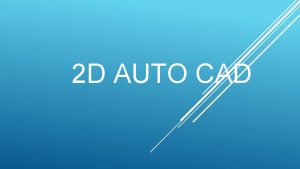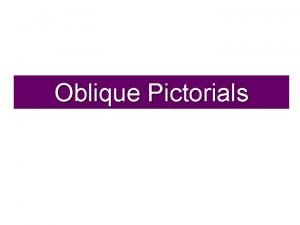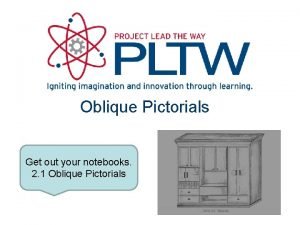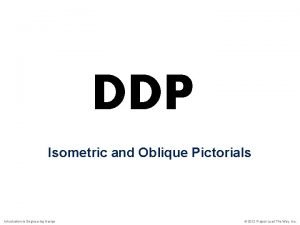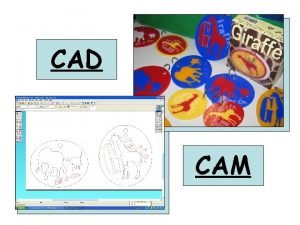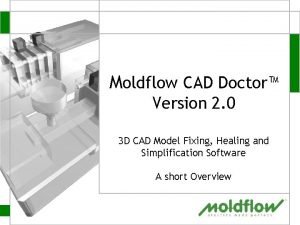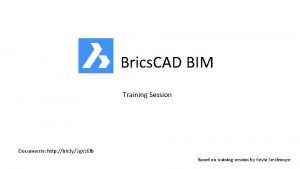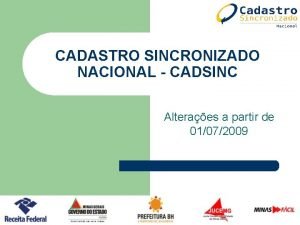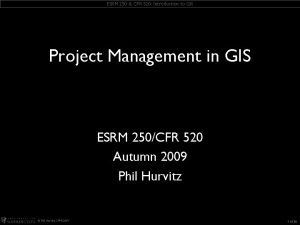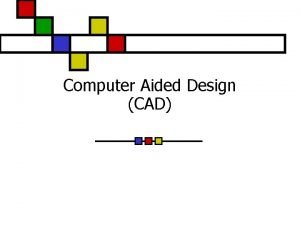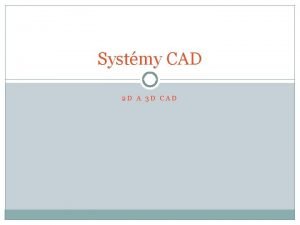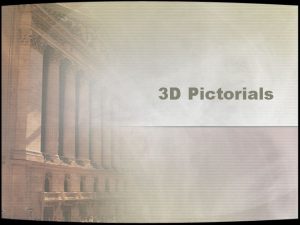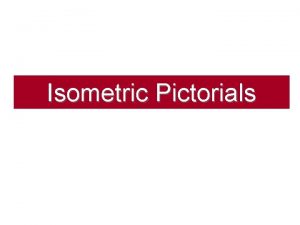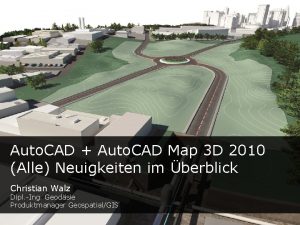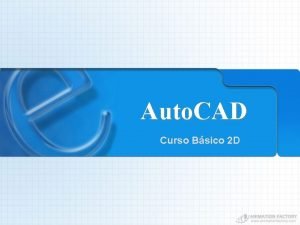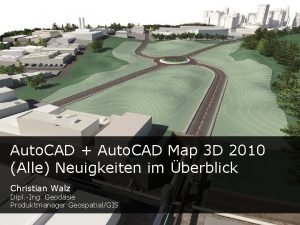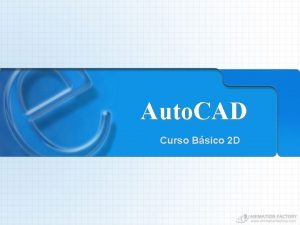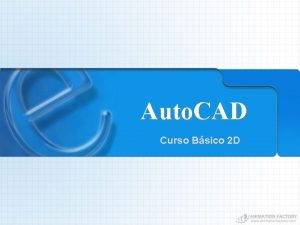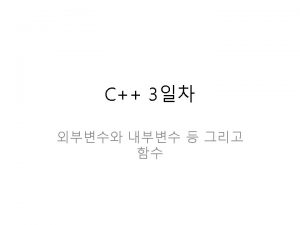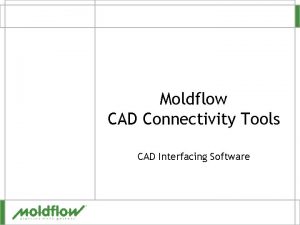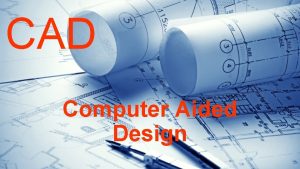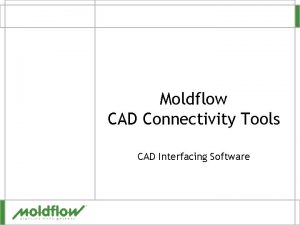Pictorials in Auto CAD Using Auto CAD to
























- Slides: 24

Pictorials in Auto. CAD Using Auto. CAD to Create Pictorial Drawings

Learning Objectives n n n Use Auto. CAD to draw an oblique of an object given orthographic views of the object Select the best orientation of an object in pictorial Define what makes a drawing a: cavalier oblique, cabinet oblique, isometric, axonometric, perspective, or orthographic views Sketch pictorials of an object (either oblique or isometric) given orthographic views of the object Use Auto. CAD to generate Isometric Drawings of objects given the orthographic views of the object.

Types n Obliques – – n Axonometrics – – n Cavalier Cabinet Isometrics Others Perspectives

Cavalier Oblique n n n Front view true size Receding Axis Angle (Normally 30°, 45° or 60°) is Variable Depth dimension (receding axis) true size

Cabinet Oblique n n n Front view true size Receding Axis Angle (Normally 30°, 45° or 60°) is Variable Depth dimension (receding axis) half size

Angles in Oblique n n n Angles in front view are drawn true size Other angles must be located using coordinates Appearance of angles may be distorted

Obliques are theoretical drawings. In reality, you can not actually view an object as an Oblique n Thin parts look very good as Obliques n Parts with angular features on multiple planes are difficult to draw as Obliques n

Circles in Oblique n n n Drawn true size in front view Drawn as ellipses on receding planes Layout using a Rhombus

Today’s Auto. CAD commands n Drawing setup – Display control – – n Editing and inquiry Drawing Aids – n n General Concepts – – ZOOM Keyboard Coordinates n MOVE COPY TRIM Object Snap – – – ENDPoint TANgent NEArest

Drawing Obliques in Auto. CAD n n n Initially you should make a rough sketch of the object to get an idea of what your drawing should look like Draw the front view as a flat orthographic view Use the COPY command along with keyboard coordinates to place the front view along the receding axis to represent all frontal surfaces in the object Connect the copies with lines representing the depth of the object. Remember to use OSNAP to assist in this process Use ERASE and TRIM as appropriate to remove unwanted lines/arcs

Example

Example

Construction of an oblique n Draw the front view using normal Auto. CAD commands and techniques

Construction of an oblique n Use the COPY command to replicate the front view to depict the depth Command: COPYE Select objects: [Other corner: [ 11 found Select objects: E <Base point or displacement>/Multiple: m E Base point: [ Second point of displacement: @. 8<40 E Second point of displacement: @1. 8<40 E Second point of displacement: E

Construction of an oblique n n Use the COPY command to replicate the front view to depict the depth ERASE the portions of the depth profiles which will not be seen.

Construction of an oblique n Add receding lines using OSNAP and the LINE command.

Construction of an oblique n TRIM and ERASE the remaining lines which would not be visible.

Isometrics n n Axes equally separated (120°) H, W, and D measurements are true size along iso. axes Angles must be located by coordinates Circles appear as ellipses on all surfaces

Drawing Isometrics in Auto. CAD n n n Initially you should do a rough sketch of the object by hand to get an idea of what your drawing should look like Switch the crosshairs to isometric mode Draw the object using the LINE and ELLIPSE commands Use F 5 to toggle the current isometric plane Use OTRHO and OSNAP to assist you in the drawing TRIM or ERASE any portions which are not visible

Using isometric snap n If the crosshairs are not set in isometric mode, use the Drafting Settings dialog box. – Right click on snap button and choose settings

Drawing Ellipses n n In isometrics, circular features which lie on the principal planes are shown as ellipses These MUST be drawn using the ELLIPSE command with the Isocircle option

Exercise Draw an Isometric pictorial of the object shown on the next slide using Auto. CAD. n The grid is a. 2” grid n Include centerlines n

Isometric Example

Think-Pair-Share n n Spend 3 minutes to list what don’t you understand about pictorials [at least 3 things] Merge your list with the person sitting next to you, AND add 1 new item to the list. You have 3 minutes. Spend 5 minutes sharing the results with another pair of students, delete questions that you can answer for each other, AND prioritize the remaining questions your list We will discuss the results, and answer any remaining questions as a class.
 Autocad meaning
Autocad meaning Oblique pictorial drawing
Oblique pictorial drawing Pictorial drawing which means “equal measure”.
Pictorial drawing which means “equal measure”. What is a cabinet oblique pictorial
What is a cabinet oblique pictorial Cavalier pictorial definition
Cavalier pictorial definition Pictorial isometric
Pictorial isometric Isometric sketching
Isometric sketching Defrost using internal heat is accomplished using
Defrost using internal heat is accomplished using Using system.collections.generic
Using system.collections.generic Cern cad
Cern cad Metylocyklopentan
Metylocyklopentan Disadvantages of cad/cam
Disadvantages of cad/cam Nano cad
Nano cad Cad doctor
Cad doctor Cad
Cad Cad sinc
Cad sinc Disadvantages of cad
Disadvantages of cad Nava definicion
Nava definicion Esrm cad
Esrm cad Cad ingegneria aerospaziale sapienza
Cad ingegneria aerospaziale sapienza Hiper cad
Hiper cad Math cad
Math cad Polyra
Polyra Orthographic projection cad
Orthographic projection cad Cad pad
Cad pad
